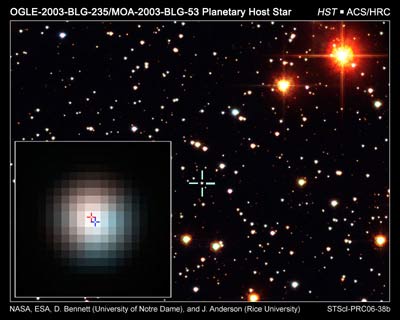Gravitational microlensing is a fascinating way to find exoplanets, provided you’re not worried about nearby targets. For the best way to do microlensing of this sort is to work with a crowded starfield, which means looking toward galactic center, where stars are numerous and distant enough that their lensing events can be studied. You’re hoping to find a star that passes in front of another as seen from Earth, in which case the gravity of the foreground star sets up the gravitational lensing effects that magnify the light of the background star.
Thus OGLE-2003-BLG-235L, which displayed a planetary companion that was discovered in 2003 using ground-based observations. The oddity here is that while the planet produced an additional brightening of the background star, thus confirming its existence, astronomers weren’t sure about the identity of the star it circled. It has taken two years and new observations by the Hubble Space Telescope to pin down OGLE-2003-BLG-235L — the foreground star — as the parent star of this particular planet, and to characterize its properties.
Image (click to enlarge): A blowup of the target (lower left) reveals the light of two stars: a foreground star and a background star superimposed on each other. The background star is the brighter, solar type star, and the foreground star is the fainter star. The motion of the foreground star, as it drifts past the more distant background star is apparent in the Hubble image taken in 2005, even though it is below Hubble’s resolution. Credit: NASA, ESA, D. Bennett (University of Notre Dame), and J. Anderson (Rice University).
A brief aside on nomenclature: The star’s designation depends on which catalog you use. OGLE-2003-BLG-235L draws on the database of the Optical Gravitational Lensing Experiment (OGLE), while the Microlensing Observations in Astrophysics (MOA) project designates the star as MOA-2003-BLG-53L. MOA is a New Zealand-based microlensing experiment that has been in place since 1995.
In the absence of a more user-friendly name, here’s what we now know about this system: The planet is roughly 2.6 Jupiter masses and in a Jupiter-like orbit around its star. OGLE-2003-BLG-235L itself is 63 percent the mass of our Sun, making it hotter and more massive than the average field star in our galaxy, which is about 30 percent Sol’s mass. The distance from Earth is 19,000 light years. Hubble could distinguish the light of the two stars because the foreground star is a different color than the background one; red and blue filters allowed astronomers to enhance the visibility of the event.



Microlensing Searches for Planets: Results and Future Prospects
Authors: B. Scott Gaudi (Ohio State University)
(Submitted on 10 Nov 2007)
Abstract: Microlensing is potentially sensitive to multiple-planet systems containing analogs of all the solar system planets except Mercury, as well as to free floating planets. I review the landscape of microlensing planet searches, beginning with an outline of the method itself, and continuing with an overview of the results that have been obtained to date. Four planets have been detected with microlensing. I discuss what these detections have taught us about the frequency of terrestrial and giant planets with separations beyond the “snow line.” I then discuss the near and long-term prospects for microlensing planet searches, and in particular speculate on the expected returns of next-generation microlensing experiments both from the ground and from space. When combined with the results from other complementary surveys, next generation microlensing surveys can yield an accurate and complete census of the frequency and properties of essentially all planets with masses greater than that of Mars.
Comments: 12 pages, 2 figures, to appear in “Extreme Solar Systems,” ASP Conference Series, ed. Debra Fischer, Fred Rasio, Steve Thorsett and Alex Wolszczan
Subjects: Astrophysics (astro-ph)
Cite as: arXiv:0711.1614v1 [astro-ph]
Submission history
From: B. Scott Gaudi [view email]
[v1] Sat, 10 Nov 2007 21:06:16 GMT (53kb)
http://arxiv.org/abs/0711.1614
Hexadecapole Approximation in Planetary Microlensing
Authors: Andrew Gould (Ohio State)
(Submitted on 17 Jan 2008)
Abstract: The frequency of microlensing planet detections, particularly in difficult-to-model high-magnification events, is increasing. Their analysis can require tens of thousands of processor hours or more, primarily because of the high density and high precision of measurements whose modeling requires time-consuming finite-source calculations.
I show that a large fraction of these measurements, those that lie at least one source diameter from a caustic or cusp, can be modeled using a very simple hexadecapole approximation, which is one to several orders of magnitude faster than full-fledged finite-source calculations. Moreover, by restricting the regions that actually require finite-source calculations to a few isolated “caustic features”, the hexadecapole approximation will, for the first time, permit the powerful “magnification-map” approach to be applied to events for which the planet’s orbital motion is important.
Comments: submitted to ApJ, 8 pages
Subjects: Astrophysics (astro-ph)
Cite as: arXiv:0801.2578v1 [astro-ph]
Submission history
From: Andrew Gould [view email]
[v1] Thu, 17 Jan 2008 17:00:38 GMT (8kb)
http://arxiv.org/abs/0801.2578
Autonomous software: Myth or magic?
Authors: Alasdair Allan, Tim Naylor, Eric S. Saunders
(Submitted on 4 Feb 2008)
Abstract: We discuss work by the eSTAR project which demonstrates a fully closed loop autonomous system for the follow up of possible micro-lensing anomalies. Not only are the initial micro-lensing detections followed up in real time, but ongoing events are prioritised and continually monitored, with the returned data being analysed automatically. If the “smart software” running the observing campaign detects a planet-like anomaly, further follow-up will be scheduled autonomously and other telescopes and telescope networks alerted to the possible planetary detection. We further discuss the implications of this, and how such projects can be used to build more general autonomous observing and control systems.
Comments: 3 pages, 4 figures, to appear in proceedings of Hot-wiring the Transient Universe (HTU) 2007, Astronomische Nachrichten, March 2008
Subjects: Astrophysics (astro-ph)
Cite as: arXiv:0802.0431v1 [astro-ph]
Submission history
From: Alasdair Allan [view email]
[v1] Mon, 4 Feb 2008 15:12:23 GMT (1605kb,D)
http://arxiv.org/abs/0802.0431